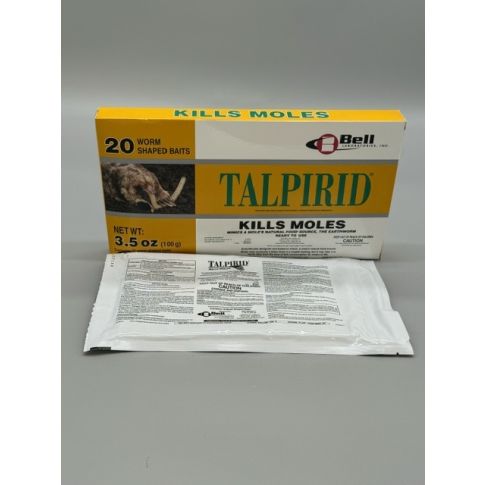Be the first to review this product
TALPIRID MOLE BAIT 20/CTN
Talpirid Mole Killer is a worm-shaped mole bait scientifically proven to kill moles in lawns and gardens. Moles usually die in their tunnels. Moles can consume a lethal dose in a single feeding and die in as little as two days.
Developed and tested on live, captured moles, Talpirid Mole Killer works where grain baits, repellents and a myriad of home remedies have failed. This revolutionary mole bait mimics the mole's natural food - the earthworm. Plus it contains special enhancers that attract moles.
| Size | 20 / CTN |
| Case Qty | 5 / CASE |
| Manufacturer | BELL LABS [view products, website] |
| EPA# | 12455-101 |
| Active Ingredient | Bromethalin |
| Label | belmo7150_talpirid_mole_bait_label_06122019.pdf |
| SDS | belmo7150_talpirid_mole_bait_sds_06122019.pdf |
| Target Pests | Moles |
| Use | Residential, commercial, or industrial buildings,OUTDOORS ONLY |
| Application | Apply Taplirid Mole Bait as directed on the Product Label |
| No Web orders to | AK, CA, HI, NY, PR, WA, NON U S LOCATIONS |
| Yield | 1 Talpirid box (20 worms) is enough for two typical treatments Bait in unopened sealed box will last up to 1 year in controlled environment. Once opened, use within 15 days. |
Talpirid developed by Bell Laboratories, Inc., is the first and only mole bait designed, developed and scientifically proven to kill moles.
Talpirid is Proven Effective Talpirid's active ingredient capitalizes on a mole's physiology. In both field and laboratory tests, Talpirid achieved outstanding acceptance and control. One Talpirid mole bait worm contains a lethal dose and can kill in 24 hours.
Talpirid mole bait mimics a Mole's Natural Food Source
Talpirid's size, shape and feel let moles consume the bait in the same manner as its primary food source, the earthworm. Special enhancers in Talpirid ensure immediate attraction and excellent product acceptance.
Talpirid is Ready-To-Use
Talpirid mole bait comes in a convenient tray of 10 worms which release freely from the tray, ready for immediate placement. The Talpirid worm trays are individually sealed in a bag for ultimate freshness and maximum shelf life.
SELECTION OF TREATMENT AREAS:
The presence of moles may be indicated by a network of subsurface runways in the turf or by a series of conical mounds of earth pushed up from deep burrows. Subsurface runways are indicated by raised ridges of vegetation and soil caused by moles foraging for food just below the soil surface. These runways are especially noticeable when the grass above them turns yellow. Conical mounds may be indicative of the location of deeper main underground runways.
APPLICATION DIRECTIONS
SUBSURFACE RUNWAYS:
Talpirid has been specially designed to mimic the natural food sources of the mole. To achieve maximum effect, TALPIRID should only be placed in areas used habitually by moles for feeding.
ESTABLISHING INITIAL ACTIVITY:
Use your finger, small wooden dowel or a narrow rod to puncture a hole in the top of subsurface runways. Be careful not to crush runways. Mark opened runways and revisit them 48 to 72 hours later. Runways that have had holes resealed within 72 hours should be baited.
BAITING ACTIVE RUNWAYS:
Make a hole in the top of the runway with a rod lightly larger than the diameter of the bait. Drop one worm into the runway, using the rod to push any exposed bait completely into the runway. Carefully reseal the runway with a small amount of dirt to exclude light. Repeat bait application every 5 to 10 feet of each active subsurface runway.
DETERMINING BAITING RESULTS:
Five (5) to 7 days after bait application, check for mole activity using the same procedure for determining initial activity. Return 48 to 72 hours later and retreat all active runs.
If Talpirid doesn't seem to work:
Here are five things to consider.
- Are you using gloves when applying the bait? Disposable rubber or Nitrile gloves are best. Not using gloves may contaminate the bait with a human scent.
- Are you applying product before or after a heavy rain? Rain and humidity can break down the bait faster than normal conditions.
- Is a chemical insecticide or fertilizer being applied to the lawn? Chemicals that are applied before or after (within a few days) of applying talpirid can affect the bait by contamination. Hence, the chemical gets on the bait by seeping through the tunnels.
- Are you following the three step process that the package instructions/brochure indicate?
- Are you baiting properly once you find the main active run? If you bait without ever doing a test to find the active tunnel(s), than the bait may never be encountered and eaten by moles. You can test for an active tunnel by following the steps outlined on the package instructions.
Refer to the Product Label for a complete lsting of application methods and approved application sites.
Talpirid developed by Bell Laboratories, Inc., is the first and only mole bait designed, developed and scientifically proven to kill moles.
Talpirid is Proven Effective Talpirid's active ingredient capitalizes on a mole's physiology. In both field and laboratory tests, Talpirid achieved outstanding acceptance and control. One Talpirid mole bait worm contains a lethal dose and can kill in 24 hours.
Talpirid mole bait mimics a Mole's Natural Food Source
Talpirid's size, shape and feel let moles consume the bait in the same manner as its primary food source, the earthworm. Special enhancers in Talpirid ensure immediate attraction and excellent product acceptance.
Talpirid is Ready-To-Use
Talpirid mole bait comes in a convenient tray of 10 worms which release freely from the tray, ready for immediate placement. The Talpirid worm trays are individually sealed in a bag for ultimate freshness and maximum shelf life.
SELECTION OF TREATMENT AREAS:
The presence of moles may be indicated by a network of subsurface runways in the turf or by a series of conical mounds of earth pushed up from deep burrows. Subsurface runways are indicated by raised ridges of vegetation and soil caused by moles foraging for food just below the soil surface. These runways are especially noticeable when the grass above them turns yellow. Conical mounds may be indicative of the location of deeper main underground runways.
APPLICATION DIRECTIONS
SUBSURFACE RUNWAYS:
Talpirid has been specially designed to mimic the natural food sources of the mole. To achieve maximum effect, TALPIRID should only be placed in areas used habitually by moles for feeding.
ESTABLISHING INITIAL ACTIVITY:
Use your finger, small wooden dowel or a narrow rod to puncture a hole in the top of subsurface runways. Be careful not to crush runways. Mark opened runways and revisit them 48 to 72 hours later. Runways that have had holes resealed within 72 hours should be baited.
BAITING ACTIVE RUNWAYS:
Make a hole in the top of the runway with a rod lightly larger than the diameter of the bait. Drop one worm into the runway, using the rod to push any exposed bait completely into the runway. Carefully reseal the runway with a small amount of dirt to exclude light. Repeat bait application every 5 to 10 feet of each active subsurface runway.
DETERMINING BAITING RESULTS:
Five (5) to 7 days after bait application, check for mole activity using the same procedure for determining initial activity. Return 48 to 72 hours later and retreat all active runs.
If Talpirid doesn't seem to work:
Here are five things to consider.
- Are you using gloves when applying the bait? Disposable rubber or Nitrile gloves are best. Not using gloves may contaminate the bait with a human scent.
- Are you applying product before or after a heavy rain? Rain and humidity can break down the bait faster than normal conditions.
- Is a chemical insecticide or fertilizer being applied to the lawn? Chemicals that are applied before or after (within a few days) of applying talpirid can affect the bait by contamination. Hence, the chemical gets on the bait by seeping through the tunnels.
- Are you following the three step process that the package instructions/brochure indicate?
- Are you baiting properly once you find the main active run? If you bait without ever doing a test to find the active tunnel(s), than the bait may never be encountered and eaten by moles. You can test for an active tunnel by following the steps outlined on the package instructions.
Refer to the Product Label for a complete lsting of application methods and approved application sites.

